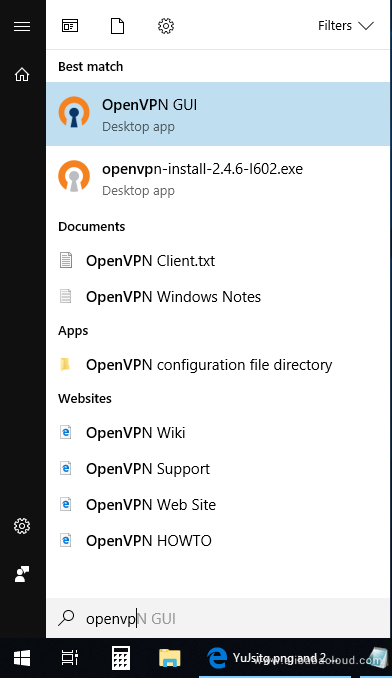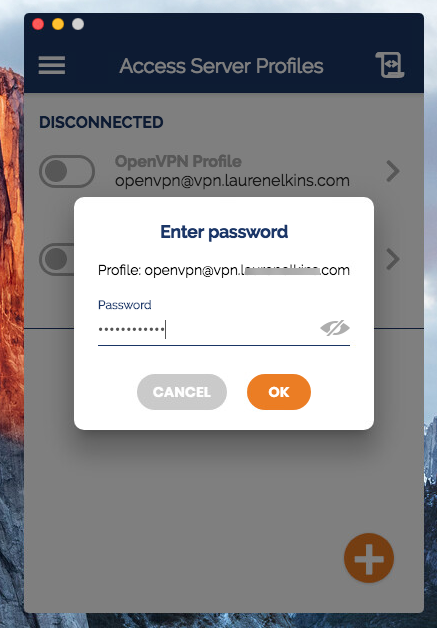

- #Openvpn client how to#
- #Openvpn client software#
- #Openvpn client Pc#
- #Openvpn client download#
- #Openvpn client windows#
Edit the lines in a way that corresponds with the actual file paths.
#Openvpn client download#
You can use the Notepad, but for editing configuration files we recommend using Notepad++ for a better experience (you can download it from here).
Open the config file with a text editor. You should also copy the certificates and keys to this directory (required files: ca.crt, server.crt, server.key, dh2048.pem). When you locate the file, make a copy, rename it and place it in the config directory of the OpenVPN folder (default path: C:\Program Files\OpenVPN\config). You can find it in the OpenVPN installation directory, sample-config folder (default: C:\Program Files\OpenVPN\sample-config) under the name server.ovpn. #Openvpn client how to#
In this section we'll be discussing how to configure an OpenVPN Tunnel (TUN) server that uses:Īs a template, we'll be using the sample configuration file that comes along with the OpenVPN installation, but we'll be adding with some minor changes to it. The generated and signed files should appear in the following directories (by default):Ĭ:\Program Files\OpenVPN\easy-rsa\pki\privateĬ:\Program Files\OpenVPN\easy-rsa\pki\issued
 Lastly, generate Diffie Hellman parameters. Omit "nopass" and you will be prompted to choose the client's password. easyrsa build-client-full Client1 nopass Note: replace Client1 with this client's Common Name (CN). Next, build certificates and keys for the clients. Next, build the server certificate and key. Begin with the certificate authority ( CA) - the root certificate file that will be used to sign other certificates and keys. Now we can start generating the certificates and keys. Step 3: generating certificates and keys Once you're done, save the file and close the editor then run the following commands: vars.bat. Set You can also set the key size for the Diffie Hellman parameters: set DH_KEY_SIZE=2048 Locate and edit the following lines in accordance with your needs: This is the template file for generating certificates, i.e., the information stored here will be offered as default values during certificate generation. Open the vars.bat file with the Notepad text editor: notepad vars.bat. This can be done with the following command. Before you can generate files with EasyRSA, you must first initialize a directory for the Public Key Infrastructure (PKI). To do so, execute this command: cd "C:\Program Files\OpenVPN\easy-rsa" Change the current directory to the EasyRSA folder. When you launch it, make sure you run it as administrator:
Lastly, generate Diffie Hellman parameters. Omit "nopass" and you will be prompted to choose the client's password. easyrsa build-client-full Client1 nopass Note: replace Client1 with this client's Common Name (CN). Next, build certificates and keys for the clients. Next, build the server certificate and key. Begin with the certificate authority ( CA) - the root certificate file that will be used to sign other certificates and keys. Now we can start generating the certificates and keys. Step 3: generating certificates and keys Once you're done, save the file and close the editor then run the following commands: vars.bat. Set You can also set the key size for the Diffie Hellman parameters: set DH_KEY_SIZE=2048 Locate and edit the following lines in accordance with your needs: This is the template file for generating certificates, i.e., the information stored here will be offered as default values during certificate generation. Open the vars.bat file with the Notepad text editor: notepad vars.bat. This can be done with the following command. Before you can generate files with EasyRSA, you must first initialize a directory for the Public Key Infrastructure (PKI). To do so, execute this command: cd "C:\Program Files\OpenVPN\easy-rsa" Change the current directory to the EasyRSA folder. When you launch it, make sure you run it as administrator: #Openvpn client windows#
It can be opened by typing cmd in the Windows search bar ( Windows button + S). For this we'll be using the EasyRSA 3 application that was installed along with OpenVPN.ĮasyRSA commands have to be executed via the Windows Command Prompt.
Now we can start preparing to generate certificates and keys. While in the 'Custom Installation' window, scroll down to find OpenSSL Utilities → EasyRSA 3 Certificate Management Scripts make sure it is installed along with OpenVPN and click 'Install Now':. Before starting the installation process, click 'Customize':. Download an OpenVPN installer file from here. The purpose of this article is to provide the know-how needed to configure a working OpenVPN server on a Windows PC. The computer in question must have a Public IP address. #Openvpn client Pc#
A PC or Laptop running on Windows 7 or a later version. The instructions apply to Windows 7 and newer systems.Ĭonfiguration overview and prerequisites īefore we begin, let's overview the configuration that we are attempting to achieve and the prerequisites that make it possible. The information provided here is geared towards users of almost any knowledge level. 
This article contains step-by-step instructions on how to create and run an OpenVPN server on a PC that runs on Windows OS.
#Openvpn client software#
OpenVPN is an open-source software application that implements virtual private network (VPN) techniques for creating secure point-to-point or site-to-site connections in routed or bridged configurations and remote access facilities.

5 Step 3: generating certificates and keys. 2 Configuration overview and prerequisites.








 0 kommentar(er)
0 kommentar(er)
